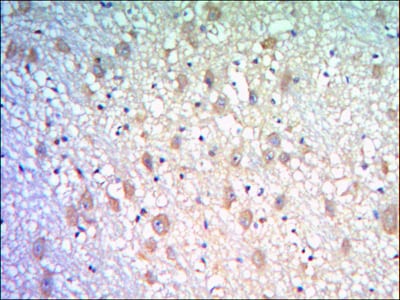
| WB | 咨询技术 | Human,Mouse,Rat |
| IF | 咨询技术 | Human,Mouse,Rat |
| IHC | 1/200 - 1/1000 | Human,Mouse,Rat |
| ICC | 技术咨询 | Human,Mouse,Rat |
| FCM | 咨询技术 | Human,Mouse,Rat |
| Elisa | 1/10000 | Human,Mouse,Rat |
| Aliases | KIAA0469; MGC99635; KLHL21 |
| Entrez GeneID | 9903 |
| clone | 2H4 |
| WB Predicted band size | 66kDa |
| Host/Isotype | Mouse IgG1 |
| Antibody Type | Primary antibody |
| Storage | Store at 4°C short term. Aliquot and store at -20°C long term. Avoid freeze/thaw cycles. |
| Species Reactivity | Human |
| Immunogen | Purified recombinant fragment of human KLHL21 expressed in E. Coli. |
| Formulation | Ascitic fluid containing 0.03% sodium azide. |
+ +
以下是3篇关于KLHL21抗体的相关文献摘要:
1. **文献名称**:*"KLHL21 regulates spindle orientation and microtubule dynamics in mitosis"*
**作者**:M. Mansfeld 等
**摘要**:研究发现KLHL21通过调控微管动力学和有丝分裂纺锤体定位,参与细胞分裂的精准调控。研究使用KLHL21抗体进行免疫荧光实验,证实其与中心体蛋白的相互作用,并揭示其缺失导致染色体分离异常。
2. **文献名称**:*"KLHL21 interacts with BARD1 to promote DNA damage response"*
**作者**:S. Rauth 等
**摘要**:本文发现KLHL21与乳腺癌相关蛋白BARD1结合,参与DNA损伤修复通路。通过KLHL21抗体进行免疫共沉淀实验,证明其通过泛素化修饰调控修复复合体的稳定性,提示其在癌症治疗中的潜在靶点价值。
3. **文献名称**:*"A Cullin3-KLHL21 E3 ubiquitin ligase complex promotes cell cycle progression"*
**作者**:J. Lin 等
**摘要**:研究揭示KLHL21作为Cullin3泛素连接酶的适配体,介导细胞周期蛋白的降解以推动G1/S期转换。利用KLHL21抗体进行Western blot分析,发现其表达水平与细胞增殖速率正相关。
4. **文献名称**:*"KLHL21 suppresses tumor metastasis by modulating EMT pathways"*
**作者**:Y. Chen 等
**摘要**:该文献报道KLHL21通过抑制上皮-间充质转化(EMT)关键蛋白,降低肿瘤转移风险。通过KLHL21抗体的免疫组化实验,发现其在多种癌症组织中低表达,并与患者预后不良相关。
以上研究均涉及KLHL21抗体在机制探索或临床关联中的应用,涵盖细胞周期、DNA修复及癌症等领域。
The KLHL21 antibody is a research tool designed to detect and study the Kelch-like protein 21 (KLHL21), a member of the Kelch-like family characterized by conserved BTB (Bric-a-brac, Tramtrack, Broad Complex) and Kelch repeat domains. KLHL21 functions as a substrate-specific adaptor for the Cullin3 (CUL3)-based E3 ubiquitin ligase complex, facilitating the ubiquitination and subsequent proteasomal degradation of target proteins. This protein plays critical roles in cellular processes such as cell cycle regulation, autophagy, DNA damage response, and cytoskeletal organization. For example, KLHL21 has been implicated in regulating the Akt signaling pathway by targeting PDPK1 (3-phosphoinositide-dependent protein kinase 1) for degradation, thereby influencing cell survival and proliferation.
KLHL21 antibodies are widely used in techniques like Western blotting, immunohistochemistry (IHC), and immunofluorescence (IF) to assess protein expression, localization, and interactions in various biological samples. Dysregulation of KLHL21 has been associated with pathological conditions, including cancers (e.g., breast, liver, and colorectal cancer) and neurological disorders, where its role in protein homeostasis and signaling pathways may contribute to disease progression. Current research focuses on elucidating KLHL21's regulatory mechanisms, its interaction partners, and its potential as a therapeutic target or biomarker. However, challenges remain in fully mapping its substrate specificity and tissue-specific functions. These antibodies are essential tools for advancing our understanding of KLHL21's biological and clinical significance.
×